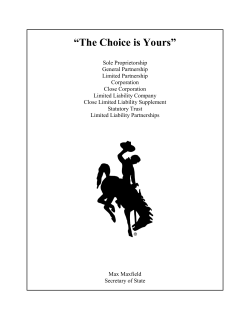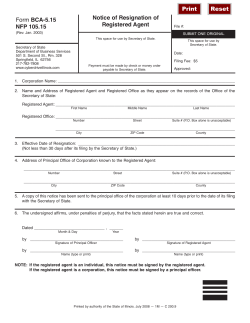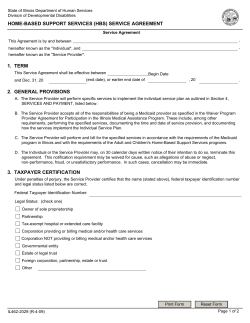
Document 87767
www.nsbdc.org (800) 240-7094 Forms of Business Ownership Which is the right one for your business? One of the first executive decisions you’ll make for your new business is choosing the type of legal organization that’s best for you. The choice you make is important because it will determine what your business can and cannot do, what will happen if someone sues you, and how both you and your business are taxed. There are basically four ways to organize a business. Listed from the simplest to sophisticated, they are: • • • • Sole Proprietorship Partnership Corporation Limited Liability Company SOLE PROPRIETORSHIP √ Is a business with one owner and the most common type of organization. √ Is not separate from the owner, but merely a different name with which the owner represents to the public. The owner and the business are inseparable. √ Is easy to form and operate. √ Is more affordable since no legal documents need to be filed in most cases. All you have to do is get a business license and start operations. √ Is a “pass-through” entity. All income and expenses pass-through to, and are filed as, part of the owner’s personal tax return. When there is a business loss, the owner will enjoy a deduction to off-set personal income. √ If the business makes a profit, it will increase the owner’s income by that amount and the owner is responsible for any taxes due. √ Whoever sues the business actually sues the owner. The owner’s personal exposure is unlimited. His personal assets can be taken to pay company obligations. PARTNERSHIP √ Has two or more owners. The details of the arrangement between the partners are outlined in a written document called a partnership agreement. √ Is not a separate legal entity from its owners. However, the partnership can hold property and incur debt in its name. UNR - UNLV Reno - Las Vegas - Henderson - Carson City - Elko - Ely - Fallon - Gardnerville - Pahrump - Winnemucca NSBDC – Forms of Business Ownership Page 2 of 4 √ Is a pass-through entity and does not pay its own income tax but files an informational tax return with the IRS (Form 1065). The pro-rata share of its income and expenses are shown on each partner’s personal return, and any taxes due are paid by the partners. √ Has the same advantages and disadvantages as the sole proprietorship but with an additional drawback. A partner can be held liable for the acts of the other partners, increasing personal liability. CORPORATION √ Is essentially an “artificial person” created and operated with the permission of the state where it is incorporated. It is a person but only “on paper”. √ Is brought to life as a regular C corporation, by filing a form with a state, known as articles of incorporation. √ √ Must have at least one stockholder. Some states require two or more. √ Actually owns and operates the business on behalf of the shareholder, under the shareholder’s total control. √ √ Protects the owners by absorbing the liability if something goes wrong. When debt is incurred in the company name, owners are not personally liable and their assets cannot be taken to settle company obligations. √ Allows owners to hire themselves as employees and then participate in company funded employee plans like medical insurance. √ Lawsuits can be brought against the company instead of the owners. S CORPORATION √ Is the same as any other business corporation with one important difference- the IRS allows it to be taxed like a partnership, a pass-through entity. √ Being an S corporation is a tax matter only, elected by filing IRS form 2553. √ In the initial years the losses of the S corporation help to offset the personal income of the owners. It can revert back to C corporation status when financial advisors to the corporation recommend it is best to do so. LIMITED LIABILITY COMPANIES (LLCs) √ Is the newest form of business organization. It is a hybrid entity that combines favorable aspects of the corporation and partnership. √ Features the pass-through taxation of the partnership, and limited liability of the corporation. UNR - UNLV Reno - Las Vegas - Henderson - Carson City - Elko - Ely - Fallon - Gardnerville - Pahrump - Winnemucca NSBDC – Forms of Business Ownership Page 3 of 4 √ Is like an S corporation without the 100 shareholder limitation. In addition, profits do not have to be distributed according to relative ownership interest. √ The law regarding LLCs is still evolving. So which is the best? Well, considering that sole proprietorships and partnerships don’t offer limited liability protection, the race appears to be between corporations and LLCs for which the only difference is how they are taxed and how they affect their owners’ personal taxes. Between these two, the corporation offers more tax planning options with the ability to file as either as S corporation or a C corporation. To decide what type of business entity is best for you, refer to the attached chart. UNR - UNLV Reno - Las Vegas - Henderson - Carson City - Elko - Ely - Fallon - Gardnerville - Pahrump - Winnemucca NSBDC – Forms of Business Ownership Page 4 of 4 Details Sole Proprietorship City tax license may be required. No state filing required. Business Formation Number of owners Only one sole proprietor Raising Capital Owner typically contributes all funds. Length of existence Terminated if business ceases or upon owner’s death Operational Requirements Relatively few legal requirements. Management Sole Proprietor has full control of management and operations. Unlimited liability. Liability Taxation Pass through taxation for income & loss Interest transferability Dissolution Best suited for Example Taxed once. Owner is responsible for any taxes due. Yes. Profits increase owner’s personal taxes. No unless business is sold to another party. Easiest. Single owner business. Taxes or product liability not a concern. Mom & Pop Ice cream Shop. BUSINESS ENTITY COMPARISON CHART General C Corporation Partnership No State filing Required to file required. An formation documents Agreement between with the State filing two or more agency. Most states parties. Partnership require annual meetings agreement should and bylaws. be created. Minimum two general Most states allow one partners person corporations; some require two to serve as officers. S Corporation Same as C corporation. Must elect S status through the IRS, additional filing required. Limited Liability Company (LLC) Required to file formation document with the State filing agency. Most states require an Operating Agreement. Same as C corp. but no more than 100 members/ Shareholders permitted. Sell stock to raise capital. Most states allow single member LLCs but some require 2 or more Perpetual as a separate legal entity Perpetual as a separate legal entity. Perpetual as a separate legal entity. Board of Directors, officers, annual meetings, and annual reporting required. Board of Directors, officers, annual meetings, and annual reporting required. Managed by the directors, who are elected by the shareholders. Shareholders are typically not personally liable for the debts of the Corporation. Some formal requirements but less formal than corporations. Taxed once. Owners responsible for any taxes due. Yes. Profits increase owners’ personal taxes. Yes. Some IRS regulations on stock ownership. Most complex. Same as C corporation. Taxed once. Owners responsible for any taxes due. Yes. Profits increase owners’ personal taxes. Depends on operating agreement. Complex. Single or multiple owner business. Owners need limited liability but want to be taxed as partnership. Real Estate Investment, Motion Picture. Partners contribute capital. More capital can be raised by adding new partners. Dissolves upon partner’s death or withdrawal, unless stated in the partnership agreement. Relatively few legal requirements. Sell stock to raise capital. Typically each partner has an equal voice, unless otherwise arranged. Unlimited liability. A partner can be held liable for the acts of the other partners, increasing personal liability Taxed once. Partners are responsible for any taxes due. Yes. Profits increase owner’s personal taxes. Managed by directors, who are elected by the shareholders. No. Shares of stock are easily transferred. Easy. Business with partners. Taxes or product liability are not a concern. Most complex. Single or multiple owner business. Owners need company funded fringe benefits and liability protection. Land Developer. Software company. Shareholders are typically not personally liable for the debts of the Corporation Double; both the corporation and shareholders are taxed. No Print shop, Pizza parlor, Interior Design. Some operating agreements allow interest to be sold. Members have an operating agreement that outlines management. Members are not typically liable for the debts of the LLC UNR - UNLV Reno - Las Vegas - Henderson - Carson City - Elko - Ely - Fallon - Gardnerville - Pahrump - Winnemucca
© Copyright 2025





















